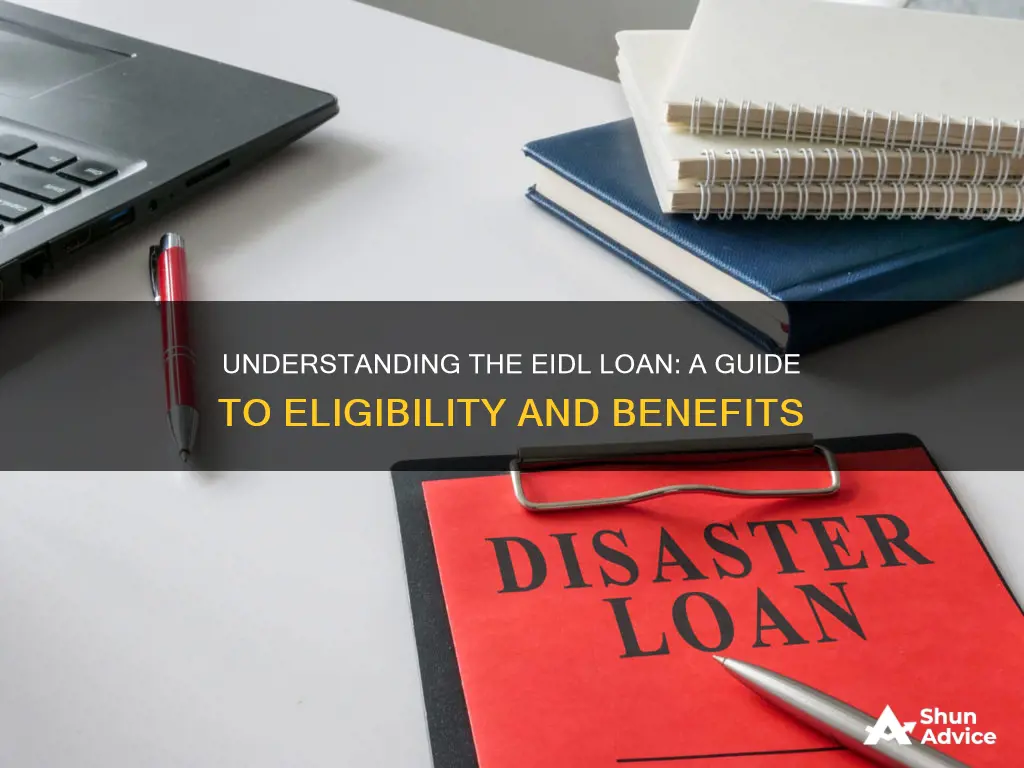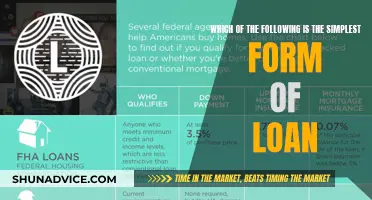
The COVID-19 Economic Injury Disaster Loan (EIDL) was a federal small business loan program that provided funding to help small businesses and private nonprofits recover from the economic impacts of the COVID-19 pandemic. The Small Business Administration (SBA) lent EIDLs directly without third-party banks as administrators. The EIDL Advance was a separate program offered during the COVID-19 pandemic that provided a cash advance of up to $10,000 per employee, which could be forgiven under certain circumstances. The EIDL loan itself is not forgivable and requires repayment of the full amount with interest.
EIDL Loan Characteristics and Values
| Characteristics | Values |
|---|---|
| Full Form | Economic Injury Disaster Loan |
| Administered by | Small Business Administration (SBA) |
| Purpose | To support small businesses' recovery from the economic impacts of the COVID-19 disaster |
| Types | EIDL Loan, EIDL Advance |
| Interest Rate | 3.75% APR (fixed), 2.75% APR for nonprofits |
| Loan Cap | $150,000 |
| EIDL Advance Cap | $10,000 per employee |
| Collateral | Business assets such as inventory, equipment, trademarks, copyrights |
| UCC Lien | Applicable for loans over $25,000 |
| Repayment | Full repayment required, no loan forgiveness |
| Payment Portal | SBA's Capital Access Financial System (CAFS) |
| Customer Service | 800-659-2955, [email protected] |
What You'll Learn
- EIDL loans are not subject to SBA loan forgiveness
- EIDL Advance funds were awarded to existing COVID-19 EIDL applicants
- UCC-1 filing on business assets for loans over $25k
- EIDL loans can be used for working capital, rent, utilities, inventory, etc
- EIDL loans are not accepting new applications, increase requests, or reconsiderations

EIDL loans are not subject to SBA loan forgiveness
The Economic Injury Disaster Loan (EIDL) is a federal small business loan program that supported small businesses' recovery from the economic impacts of the COVID-19 disaster. The U.S. Small Business Administration (SBA) offered two types of COVID-19 EIDL funding: loan funds for working capital and other normal operating expenses, and advance funds for existing COVID-19 EIDL applicants who met certain criteria.
It is important to note that dissolving your business will not provide EIDL loan forgiveness if the loan is over $25,000. In this case, the business assets should be liquidated, with the proceeds going to the SBA, and the SBA will release its lien on the assets. The SBA may also launch an inquiry into your business, even after dissolution, and find that you misapplied funds, which could make you personally liable for the loan.
Furthermore, if you committed fraud when obtaining the loan, you may be held criminally liable by the federal government. The SBA is focused on rooting out fraud, and while inquiries are rare, they can result in personal liability for the loan.
While EIDL loans are not eligible for forgiveness, businesses can still refinance outstanding debt through various options such as SBA 7(a) loans, business term loans, or lines of credit to better manage their financial obligations.
Understanding Pledge Loans: Borrowing with Collateralized Securities
You may want to see also

EIDL Advance funds were awarded to existing COVID-19 EIDL applicants
The Economic Injury Disaster Loan (EIDL) is a federal small business loan program that supported small businesses' recovery from the economic impacts of the COVID-19 disaster. The U.S. Small Business Administration (SBA) provided EIDL loans to help small businesses, impacted cooperatives, and private nonprofit organizations recover from substantial economic injury.
The EIDL Advance funds were awarded to existing COVID-19 EIDL applicants who met certain criteria. These advances are similar to grants, but without the typical U.S. government grant requirements. The SBA offered two types of advance EIDL funding that did not need to be repaid.
For COVID-19 EIDL applicants who had already submitted their applications, the SBA continued to process them on a first-come, first-served basis. The SBA also provided an EIDL Emergency Advance of up to $10,000, which could be used to cover payroll and other operating costs while the EIDL application was being processed. This advance was made available within days of a successful application submission.
It is important to note that as of January 1, 2022, the SBA stopped accepting applications for new COVID-19 EIDL loans or advances. As of May 6, 2022, the SBA is no longer processing loan increase requests or reconsideration requests for previously declined loan applications.
Hero Loans: A Financial Lifeline for Brave Citizens
You may want to see also

UCC-1 filing on business assets for loans over $25k
The Economic Injury Disaster Loan (EIDL) is a federal small business loan program that supported small businesses' recovery from the economic impacts of the COVID-19 disaster. The U.S. Small Business Administration (SBA) offered two kinds of advance EIDL funding that did not need to be repaid.
If you apply for an EIDL loan over $25,000, the SBA will place a UCC-1 filing on your business assets. A UCC-1 filing is a Uniform Commercial Code (UCC) lien filing, which is an official claim to collateral that lenders file on the assets of loan applicants. A UCC-1 filing is a public legal notice filed by creditors that declares their right to seize assets in the event of default.
A UCC lien filing legally enables a lender to sell the borrower's assets if the borrower defaults on the loan. The lender can file a blanket UCC lien, claiming all business assets, or they can lay claim to specific assets. This is common practice for business loans and personal loans. If you are approved for a business loan that is secured by collateral, such as an EIDL loan over $25,000, the lender will typically file a UCC lien right away.
The UCC filing will appear on your business credit report, which could deter future lenders. If you need to apply for another loan in the future, a secondary lender may be hesitant because they will be in the "junior" lien position. This means that if you default on your loan, the SBA will be paid off before them. Some lenders do not want to assume the junior position unless the value of your assets is enough to cover your EIDL loan and the second loan.
Lending Club Hard Pull: What You Need to Know
You may want to see also

EIDL loans can be used for working capital, rent, utilities, inventory, etc
Economic Injury Disaster Loans (EIDLs) are a type of SBA Disaster Assistance program that provides economic relief to small businesses, small agricultural cooperatives, and most private nonprofit organizations that have suffered substantial economic injury due to a disaster, such as the COVID-19 pandemic.
EIDL funds can be used for working capital and to cover normal operating expenses, including payroll, rent, utilities, insurance payments, and inventory. This means that businesses can use the loan to pay outstanding bills and obligations incurred before the disaster, such as payments to suppliers, vendors, and contractors.
Additionally, EIDL loans can be used to make payments on existing debt obligations, including mortgages, loans, and other liabilities, provided that the debt was incurred before the disaster. This is particularly helpful for businesses that need to continue making payments on existing loans or leases during the disaster recovery period.
It is important to note that EIDL funds cannot be used for expanding facilities, buying fixed assets, repairing physical damages, refinancing debt, paying out dividends or bonuses, or paying back loans to stockholders or principals.
Becoming a Loan Signing Agent: California Requirements and Steps
You may want to see also

EIDL loans are not accepting new applications, increase requests, or reconsiderations
The COVID-19 Economic Injury Disaster Loan (EIDL) and EIDL Advance programs were introduced to provide funding to help small businesses recover from the economic impacts of the COVID-19 pandemic. There were two types of COVID-19 EIDL funding: the loan funds were to be used for working capital and other normal operating expenses, while the EIDL Advance funds were awarded to existing COVID-19 EIDL applicants who met certain criteria.
As of January 1, 2022, the Small Business Administration (SBA) stopped accepting applications for new COVID-19 EIDL loans or advances. As of May 6, 2022, the SBA is no longer processing COVID-19 EIDL loan increase requests or requests for reconsideration of previously declined loan applications. The COVID-19 EIDL portal is also now closed.
The SBA has lent EIDLs directly without third-party banks as administrators and now has a portfolio of loans totalling approximately $387 billion lent to 4 million different borrowers. With significant default rates occurring on these loans, the SBA is facing challenges in dealing with EIDL loans.
While EIDLs are not subject to SBA loan forgiveness, there are ways to achieve relief from your EIDL. If you need temporary relief from your EIDL loan, you can apply for hardship with the SBA, which reduces your payments to 10% of the balance owed for six months. This option is available for borrowers experiencing short-term financial challenges, and you must be current on your EIDL payments to obtain this relief. It's important to note that interest will continue to accrue on your loan during the deferment period, and a final balloon payment will be due at loan maturity if you do not make voluntary payments.
Understanding Your First Loan: Starter Loans Explained
You may want to see also
Frequently asked questions
EIDL stands for Economic Injury Disaster Loan. It is a federal small business loan program that supported small businesses' recovery from the economic impacts of the COVID-19 disaster.
EIDL loans can cover up to six months of working capital or operating expenses, with a cap of $150,000 for businesses that qualify. The interest rate for EIDL loans is 3.75% APR (fixed), with a 2.75% APR available for nonprofit organizations. EIDL Advances were awarded to existing COVID-19 EIDL applicants who met certain criteria and did not need to be repaid.
To pay off your EIDL loan, you will need your SBA loan number. You can then visit the pay.gov website to make a payment.







